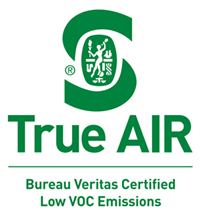True Air©
Certification Program Verifies Products meet Rigorous Standards for Low Emissions of VOCs
VOCs are volatile organic compounds or chemicals that can be found in all types of consumer products including the ones used to build and furnish our homes and businesses. These types of chemicals can be released (or off-gassed) from those products over time into the surrounding environment and air that we breathe. This is the “new smell” odor that can be associated with products or their packaging. Some, but not all VOCs are dangerous to human health and can cause harm to the environment.
To address potential VOC exposure concerns, retailers are implementing programs to evaluate raw materials and construction processes, screen suppliers and test and retest furniture and furnishing that they sell. This helps to verify products meet the highest standards for VOC emissions thereby contributing directly to the indoor air quality in rooms where those products are used.
What is the BV True AIR program?
 |
BV True AIR is an ISO 17065 compliant certification program that allows architects, suppliers and consumers to select furniture, furnishings and construction materials that have been stringently tested and proven to meet strict VOC standards that will directly contribute to a healthier indoor environment inside buildings, workspaces and homes. |
The BV True AIR certification program is currently available in the US and will expand to Asia in late 2017.
Why BV True AIR?
• Standardized testing fees, no fees beyond annual compliance testing and no licensing fee for product registration or logo usage.
• Completely transparent process. Clients may observe testing, have access to all analytical data files and clear concise reports that explain the process, methods used, conclusions and recommendations.
• IHLAP Accreditation, ISO/IEC 17025 Testing and 17065 Program Compliancy: MAS is the ONLY emissions testing lab and certification program that holds both AIHA and ISO certificates.
• Certified products may qualify for LEED points.
OUR APPROACH
The BV certification program focuses on identified core VOCs of concern, which have established methods and limits, as well as over 100 VOCs, that are currently on watch lists (i.e. Google Red List, Healthy Hospital, etc.), that may be identified as concerning in the future. This focused approach is the most cost-effective from a testing and manufacturing limiting standpoint.
Pre-Certification
• Transparent process to help manufacturers understand the contributing variables (process, raw materials, substrates, temperature…)
• Review of material safety data sheets for suspect construction materials and components
• Manufacturing process mapping includes identification of material and component suppliers
• Manufacturing process on-site auditing
• Chamber testing of representative suspect materials including worst case scenarios for product certification and broad product line bracketing
Certification
• Based on testing of the complete end product with verification testing annually to confirm compliance
• Certified products bear the BV True AIR mark with a code that allows the purchaser to see the certified product in the BV online database
• For products that have alternative components, each component may be tested to determine their baseline VOC content with final testing only to occur on the complete end product with worst case construction/formulation
Surveillance
• Compliant product will be recertified until the next scheduled verification test (typically 1 year)
• If the product is noncompliant, the manufacturer must perform a root cause analysis and corrective actions to bring the product into compliance
WHY CHOOSE BUREAU VERITAS?
Reputation – For over 35 years, we have worked successfully with top manufacturers and retailers around the world to help them better manage risk and regulatory compliance.
Worldwide Locations – With locations close to sourcing areas in over 40 countries, we offer you the convenience of global coverage with local service where you need it.
Technical Knowledge & Leadership – Our staff participate in the development of international, industry and regulatory standards worldwide, keeping you and us at the forefront of changes in safety requirements and testing methods.
Personalized Service – We are committed to meeting your evolving needs as you anticipate new market trends. We offer customized quality assurance services throughout your supply chain. Providing you with the highest levels of service is our priority.
FREQUENTLY ASKED QUESTIONS
-
Are other certification programs more stringent than BV True AIR program?
The simplest answer is no. Scientists, doctors, toxicologists and industrial hygienists that evaluate and establish limits for VOCs to protect human health and the environment have set limits for only the 30 to 35 chemicals addressed by the BV True AIR program. That is not a coincidence; rather it’s a matter of scientific integrity.
-
How do consumers identify products are IAQ compliant and certified under the BV True AIR program?
All IAQ compliant products will carry a registered “mark” displayed on the shipping container similar to that depicted above. In addition, IAQ compliance of products can be verified online.
-
What types of raw materials and products are most often recognized as potentially significant VOC emitters?
This can vary greatly based on manufacturing processes and product age. That said, engineered woods like MD, particleboard and to lesser extent plywood (historically made with formaldehyde resins) are widely recognized as significant sources of formaldehyde off-gassing. Many paints, clear and tinted finishes are also high emitters of VOCs based on their solvent base and other reactive chemicals used in their formulation. Lastly the use of glues and adhesives, if not fully cured and thoroughly sealed, often release VOCs. Aside from these materials, most petroleum-based products and certain soft plastics/polymers will also emit target VOCs.